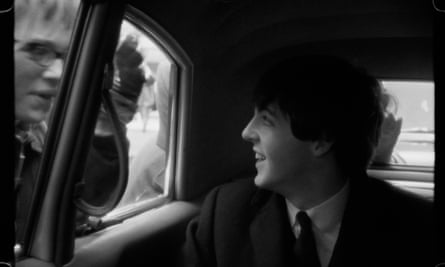The Beatles’ breaking of America – that mythic, ecstatic moment which restored Britain’s postwar pride and became an enduring cornerstone of our soft power self-respect – is the subject of this absorbing documentary from director David Tedeschi; Martin Scorsese is a producer and interviews Ringo himself in the present day, with Paul speaking to camera separately. It also uses the intimate hotel-room and backstage footage shot at the time by the Maysles brothers, Albert and David.
The film is a record of the band’s arrival in New York in 1964, and their legendary live appearance on The Ed Sullivan Show, the host resembling a wary, jowly Richard Nixon. Craig Brown’s book One Two Three Four points out that the Beatles’ appearance on the show followed an interminable succession of forgotten support acts who, though they may have eagerly accepted the TV booking at the time, were doomed to be hated by an impatient nation for not being the Beatles, for ever tainted by their sheer irrelevance. This film shows one of the TV audience yawning at one of these lesser mortals.
The band’s first concert in the US was in Washington DC, where the staff and officials at a British embassy reception notoriously disgraced themselves with their boorish snobbery towards the band; a well-spoken chap is shown sneering that he had no patriotic pride about the Beatles. Then it was back to New York to play Carnegie Hall, then on to Miami where they got to goof around with Muhammad Ali, though there is no film footage of that.
As ever, the four faces of the Beatles glow with incredulous bafflement and joy at the surreal storm swirling around them; they radiate an inexhaustible, almost supernatural energy, cracking wise and laughing, and apparently never in a bad mood with the cameras that are forever being shoved in their faces. They are good-tempered and bemused by the New York radio DJ Murray Kaufman, or Murray the K, who had somehow managed to fluke his way into hanging out with them in their hotel room, and no one quite knows who allowed him to do this. The film gives us some great closeups of the band’s faces while they are playing – I’d never noticed before that George sometimes briefly appeared to zone out on stage.
Eye of the storm … Paul McCartney in Beatles ’64. Photograph: 2024 Apple Corps Ltd.Writer Joe Queenan chokes up while remembering how he felt when he first heard the Beatles on the radio; that eerie alchemy of voices, at once galvanised with rock’n’roll energy and yet innocent and unthreatening. They were cathedral choristers of romantic joy, and the band that gave white America permission to rock out and lift their spirits after the Kennedy assassination. Some of the documentary is interested in how soft, and even exotically non-binary, the Beatles looked – so different from what Betty Friedan is shown describing as the crew-cut Prussian masculinity that was mandatory for American manhood at the time. (Again, without knowing it, they paved the way for America’s acceptance of Brit-androgynous glam rock.)
Photographer Harry Benson is interviewed in the present day, confiding that John, nervous about how he and the others would go down with the US public, found himself talking about Lee Harvey Oswald. Lennon is also shown making a pertinent point: “The Beatles and their ilk were created by the vacuum of non-conscription … we were the army that never was.” National service was abolished … and rock’n’roll took its place? It’s an intriguing thought, though it should be said that Elvis Presley did military service.
And what is still amazing is how brief an instant it was; in just a few years, the Beatles and their music would evolve into something completely different. A few years after that, they would break up, while still only in their 20s. An amazing split-second of cultural history.
skip past newsletter promotionSign up to Film Weekly
Take a front seat at the cinema with our weekly email filled with all the latest news and all the movie action that matters
after newsletter promotion
Beatles ’64 is on Disney+ from 29 November.
∎
